| Pages:
1
..
16
17
18
19 |
blogfast25
International Hazard
    
Posts: 10562
Registered: 3-2-2008
Location: Neverland
Member Is Offline
Mood: No Mood
|
|
Music notes! (Ct'nued)
The Amplitude Spectrum:
We now need to derive values for A<sub>n</sub> in:
y(x,t)=∞∑n=1Ancos(nπctL)sin(nπxL)
We do this by using the initial condition (see first page of the full derivation):
y(x,0)=f(x)
Since as t=0, all the time dependent cosine terms drop out, which leaves us with:
y(x,0)=f(x)=∞∑n=1Ansin(nπxL)
In material not covered in this thread it’s proved that:
An=2L∫L0f(x)sin(nπxL)dx
Here’s f(x):
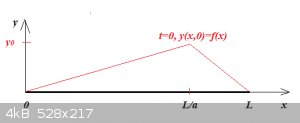
Obviously, f(x) is not a continuous function, as it’s gradient changes abruptly changes at L/a but we can construct two linear function that act
resp. on 0 < x < L/a and L/a < x < L:
f1(x)=ay0Lx and f2(x)=ay0(a−1)L(L−x)
A<sub>n</sub> then becomes:
An=2L[∫L/a0f1(x)sin(nπxL)dx+∫LL/af2(x)sin(nπxL)dx]
An=2ay0L2[∫L/a0xsin(nπxL)dx+1a−1∫LL/a(L−x)sin(nπxL)dx]
An=2ay0L2[∫L/a0xsin(nπxL)dx+La−1∫LL/asin(nπxL)dx]−1a−1∫LL/axsin(nπxL)dx]
This isn’t a particularly difficult integral but it is tedious and I’ll only present the final result:
An=4ay0n2π2sin(nπa)
The A<sub>n</sub> should be seen as amplitudes, associated with each frequency and they vary inversely with
n<sup>2</sup>:
f1,2f1,3f2,4f1,...
A1,A14,A19,A116,...
So the amplitudes diminish very quickly with increasing values of n.
We can also see that the A<sub>n</sub> increase with y<sub>0</sub> but are independent of L.
The spectrum:
Ancos(nπctL)
... determines the timbre (as do other factors like instrument shape) of the note.
[Edited on 12-6-2016 by blogfast25]
|
|
|
aga
Forum Drunkard
    
Posts: 7030
Registered: 25-3-2014
Member Is Offline
|
|
Quote: Originally posted by blogfast25  | This isn’t a particularly difficult integral but it is tedious and I’ll only present the final result:
An=4ay0n2π2sin(nπa)
|
Looks good to me : an integration problem that Can be solved and has an answer that can be used to check if i did it right.
Deffo gonna attempt it.
Might need more paper for this one ...
|
|
|
blogfast25
International Hazard
    
Posts: 10562
Registered: 3-2-2008
Location: Neverland
Member Is Offline
Mood: No Mood
|
|
Quote: Originally posted by aga  |
Looks good to me : an integration problem that Can be solved and has an answer that can be used to check if i did it right.
Deffo gonna attempt it.
Might need more paper for this one ... |
Lots of paper, yes. You end up with like 6 individual pieces you need to put back together again! But it requires only listed integrals (see cheat
sheet). More lots of algebra than calculus, really...
|
|
|
blogfast25
International Hazard
    
Posts: 10562
Registered: 3-2-2008
Location: Neverland
Member Is Offline
Mood: No Mood
|
|
Music notes! (Ct'nued)
Standing waves in the string:
So far our vibrating string time-dependent equation is:
y(x,t)=∞∑n=1Ancos(nπctL)sin(nπxL)
Where the amplitude coefficients A<sub>n</sub> have been determined above.
Now look at an individual term:
cos(nπctL)sin(nπxL)
Using the well-known trigonometric identity:
cosαsinβ=12(sin(α+β)+sin(α−β))
... y(x,t) can then be reworked to:
y(x,t)=12∞∑n=1An(sinnπ(x+ct)L+sinnπ(x−ct)L)
In:
sinnπ(x+ct)L+sinnπ(x−ct)L
... the left hand term represents a wave travelling from 0 to L and the right hand term an identical wave travelling from L to 0. The superposition
(sum) of both is a standing wave. In that interpretation the vibrating string is a superposition of a spectrum of standing waves with
harmonic wavelengths and frequencies and diminishing amplitudes:
Standing waves (amplitudes not to scale) in a string:
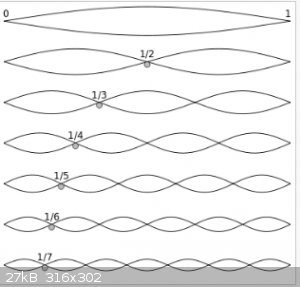
(Source of pic)
<hr>
Next up: modelling the process of diffusion.
[Edited on 13-6-2016 by blogfast25]
|
|
|
blogfast25
International Hazard
    
Posts: 10562
Registered: 3-2-2008
Location: Neverland
Member Is Offline
Mood: No Mood
|
|
Modelling diffusion
Diffusion is an important mass transport phenomenon and a part of many chemical, biological and physical processes. There are also some really
interesting and colourful experiments that illustrate it (I’ll suggest one further down).
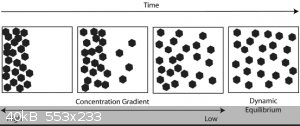
On the left hand side concentration of a species (e.g. a dye) is high. Diffusion causes concentration to level out over time. The rate of diffusion is
proportional to the concentration gradient of the solute, acc. to Fick’s first law, here in one spatial dimension only:
J=−D∂u∂x
Where J is the diffusion flux (in mol m<sup>-2</sup> s<sup>-1</sup> , D the diffusion coefficient (aka the diffusivity) (in m<sup>2</sup> s<sup>-1</sup> , D the diffusion coefficient (aka the diffusivity) (in m<sup>2</sup> s<sup>-1</sup> and u the concentration of the species (in mol m-3). The negative sign is
needed because the partial derivative is negative (for a positive J). and u the concentration of the species (in mol m-3). The negative sign is
needed because the partial derivative is negative (for a positive J).
From it, Fick’s second law, aka the diffusion equation, can be derived:
∂u∂t=D∂2u∂x2for: 0≤x≤L
In shorthand:
ut=Duxx
We’ll apply this to a long, narrow tube, filled with a dye solution and closed off at both ends:
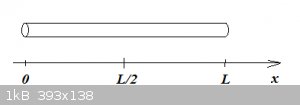
As initial condition we set:
u(x,0)=f(x)
Where f(x) is the initial distribution of dye at t=0.
Now for some boundary conditions. As the tube is closed off at both ends, no mass transfer can take place through these boundaries. With Fick’s
first law this means:
0=D∂u∂x⟹∂u∂x=0at x=0,x=L
... at all times. In shorthand:
ux(0,t)=0and: ux(L,t)=0
Now for our Ansatz, we assume that:
u(x,t)=X(x)T(t)
Where X(x) depends only on x and T(t) only on t. Inserting into the diffusion equation we get:
X(x)T′(t)=DT(t)X″
Divide both sides by X(x)T(t), rearrange slightly and dispense with the (x) and (t) notation and we get:
\frac{1}{D}\frac{T'}{T}=\frac{X''}{X}
Introducing the separation constant λ:
\frac{1}{D}\frac{T'}{T}=\frac{X''}{X}=-\lambda
Splitting then gives us two ordinary DEs:
X''+\lambda X=0\:\text{and: }T'+\lambda DT=0
<hr>
Next: solving the separated DEs.
[Edited on 15-6-2016 by blogfast25]
|
|
|
blogfast25
International Hazard
    
Posts: 10562
Registered: 3-2-2008
Location: Neverland
Member Is Offline
Mood: No Mood
|
|
Modelling diffusion (Ct'nued)
So far we obtained the fully separated DEs:
X''+\lambda X=0\:\text{and: }T'+\lambda DT=0
1. Solving the left hand side first:
X''+\lambda X=0
X=c_1\sin(\sqrt{\lambda}x)+c_2\cos(\sqrt{\lambda}x)
With the first boundary condition:
u_x(0,t)=X'(0)T(t)=0 \implies X'(0)=0
X'=c_1\sqrt{\lambda}\cos(\sqrt{\lambda}x)-c_2\sqrt{\lambda}\sin(\sqrt{\lambda}x)=0
x=0 \implies c_1=0
Which gives us:
X=c_2\cos(\sqrt{\lambda}x)
With the second boundary condition:
u_x(L,t)=X'(L)T(t)=0 \implies X'(L)=0
X’(L)=-c_2\sqrt{\lambda}\sin(\sqrt{\lambda}L)=0
\implies \sqrt{\lambda}L=n\pi
\lambda=\Big(\frac{n\pi}{L}\Big)^2\:\text{for: }n=0,1,2,3,...
X=c_2\cos\Big(\frac{n\pi x}{L}\Big)
Note that the series n=0,1,2,3,... includes the zeroth term because X is of the cosine form (a consequence of the boundary condition). Had X been of
the sine form then n=0 would be a trivial solution, making u(x,t) zero over the entire x-domain. But cos 0 is not zero (it’s one). For that reason
the n=0 term has to be included in the cosine series.
2. Solving the right hand equation:
T'+\lambda DT=0
T=Ae^{-\lambda Dt}=Ae^{-\Big(\frac{n\pi}{L}\Big)^2Dt}\:\text{for: }n=0,1,2,3,...
So with u(x,t)=T(t)X(x):
u_n=A_ne^{-\Big(\frac{n\pi}{L}\Big)^2Dt}\cos\Big(\frac{n\pi x}{L}\Big)
And with the Superposition Principle:
u(x,t)=A_0+\displaystyle \sum_{n=1}^{\infty}A_ne^{-\Big(\frac{n\pi}{L}\Big)^2Dt}\cos\Big(\frac{n\pi x}{L}\Big)
The term A<sub>0</sub> stems from the fact that for n=0 both the exponential factor and the cosine factor of the zeroth term equal one
(1). That way the series can be started at n=1.
In the so far unused initial condition u(x,0)=f(x), the exponential factors all become 1 (e0=1), so we get:
u(x,0)=f(x)=A_0+\displaystyle \sum_{n=1}^{\infty}A_n\cos\Big(\frac{n\pi x}{L}\Big)
As in the vibrating spring problem, the coefficients A<sub>n</sub> are determined from:
A_n=\frac{2}{L}\int_0^Lf(x)\cos\Big(\frac{n\pi x}{L}\Big)dx
<hr>
Next we’ll use two realistic initial dye distributions (u(x,0)=f(x)) and do some plotting of u(x,t)!
[Edited on 17-6-2016 by blogfast25]
|
|
|
Richard3050
Harmless

Posts: 17
Registered: 20-3-2016
Member Is Offline
Mood: No Mood
|
|
Chemistry! For beginners, with a ‘no elements’ approach!
"Science knowledge only adds to the excitement... I don't understand how it subtracts."
|
|
|
blogfast25
International Hazard
    
Posts: 10562
Registered: 3-2-2008
Location: Neverland
Member Is Offline
Mood: No Mood
|
|
Welcome to the thread!
|
|
|
blogfast25
International Hazard
    
Posts: 10562
Registered: 3-2-2008
Location: Neverland
Member Is Offline
Mood: No Mood
|
|
Modelling diffusion (Ct'nued)
To approximately evaluate the diffusion equation graphically, let’s try two different initial distributions of the dye in the tube.
1. Dye is initially concentrated in the centre of the tube:
We have a constant concentration u<sub>0</sub> over a narrow length a, centred about L/2, like this:
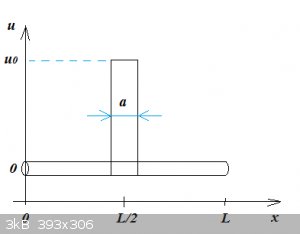
Now we calculate the coefficients A<sub>n</sub>:
A_n=\frac{2}{L}\int_0^Lf(x)\cos\Big(\frac{n\pi x}{L}\Big)dx
A_n=\frac{2}{L}\int_{\frac{L-a}{2}}^{\frac{L+a}{2}}u_0\cos\Big(\frac{n\pi x}{L}\Big)dx
A_n=\frac{2u_0}{n\pi}\big[\sin\Big(\frac{n\pi x}{L}\Big)\Big]_{\frac{L-a}{2}}^{\frac{L+a}{2}}
A_n=\frac{2u_0}{n\pi}\Big[\sin\Big(\frac{n\pi}{2}+\frac{n\pi a}{2L}\Big)-\sin\Big(\frac{n\pi}{2}-\frac{n\pi a}{2L}\Big)\Big]
Using the well-known trigonometric identity:
\sin(\alpha + \beta)-\sin(\alpha - \beta)=2\cos\alpha \sin \beta
A_n=\frac{4u_0}{n\pi}\cos \frac{n\pi}{2} \sin \frac{n\pi a}{2L}
Now we apply the small angle approximation for sine functions:
2L \gg n\pi a \implies \sin\frac{n\pi a}{2L} \approx \frac{n\pi a}{2L}
A_n\approx \frac{2u_0a}{L}\cos \frac{n\pi}{2}
Which gives:
A_0=\frac{2u_0a}{L}
A_1=0
A_2=-\frac{2u_0a}{L}
With:
u(x,t)=A_0+\displaystyle \sum_{n=1}^{\infty}A_ne^{-\Big(\frac{n\pi}{L}\Big)^2Dt}\cos\Big(\frac{n\pi x}{L}\Big)
Applied to the first three terms only (n=0, n=1, n=2):
u(x,t) \approx \frac{2u_0a}{L}-\frac{2u_0a}{L}e^{-4\Big(\frac{\pi}{L}\Big)^2Dt}\cos\Big(\frac{2\pi x}{L}\Big)
u(x,t) \approx \frac{2u_0a}{L}\Big[1-e^{-4\Big(\frac{\pi}{L}\Big)^2Dt}\cos\Big(\frac{2\pi x}{L}\Big)\Big]
Before we do some graphical plotting, a word about time scales. To allow dimensionless plotting we’ll use dimensionless time
t<sub>r</sub>:
t_r=\frac{D}{L^2}t
\implies t=\frac{L^2}{D}t_r
The following resource:
http://webserver.dmt.upm.es/~isidoro/dat1/Mass%20diffusivity...
... lists some values for D for common chemicals in water. They are typically in the order of 10<sup>-9</sup> m<sup>2</sup>
s<sup>-1</sup>!
Assuming a tube length of 10 cm (0.1 m), then t= 1 x 10<sup>7</sup> x t<sub>r</sub> = 16 weeks x t<sub>r</sub>!
Diffusion in liquids is a decidedly slow process.
Here’s the result using the first three terms approximation. All parameters are relative values.
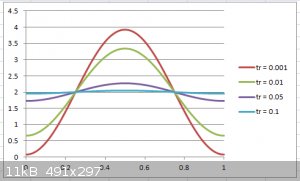
Vertical axis: relative concentration, horizontal axis: relative time t<sub>r</sub>.
2. Dye is initially concentrated in the left hand side of the tube:
If a narrow region 0 < x < a has an initial concentration of u<sub>0</sub>, then calculation of A<sub>n</sub> yields:
A_n \approx \frac{2u_0a}{L}
We’ve used the following 4 term approximation for u(x,t):
u(x,t) \approx \frac{2u_0a}{L}\Big[1+e^{-\frac{\pi^2}{L^2}Dt}\cos\Big(\frac{\pi x}{L}\Big)+e^{-\frac{4\pi^2}{L^2}Dt}\cos\Big(\frac{2\pi
x}{L}\Big)+e^{-\frac{9\pi^2}{L^2}Dt}\cos\Big(\frac{3\pi x}{L}\Big)\Big]
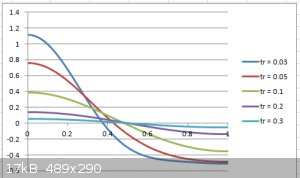
Vertical axis: relative concentration, horizontal axis: relative time t<sub>r</sub>.
3. Suggested diffusion experiment:
Place a small amount of potassium permanganate crystals at the bottom of a test tube. Add about 0.5 ml of water and swirl gently to dissolve some of
the crystals. Now carefully (so as not to disturb the permanganate layer) pipette some water into the test tube, filling it to about half way. Stopper
and place in an undisturbed place, preferably of constant temperature (convection currents will promote advective diffusion!)
Be patient and watch the permanganate diffuse through the water.
[Edited on 18-6-2016 by blogfast25]
|
|
|
blogfast25
International Hazard
    
Posts: 10562
Registered: 3-2-2008
Location: Neverland
Member Is Offline
Mood: No Mood
|
|
Particle in a 2D circular box with zero potential energy
1. Introduction:
We previously derived the wave functions of a particle in 1D box, here. The wave functions for 2D rectangles and 3D cuboids can be found easily by means of Separation of
Variables of the Schrödinger equation.
The solutions lead to some interesting plots, like these:
ψ<sub>2,2</sub> for a particle in a rectangular box (with zero potential energy, length twice the width):
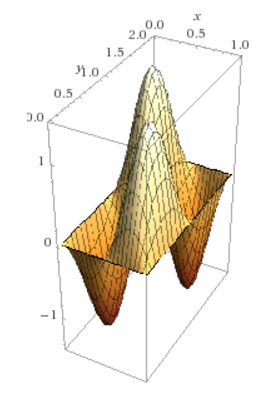
The probability density ψ<sup>2</sup><sub>2,2</sub> of the same wave function:
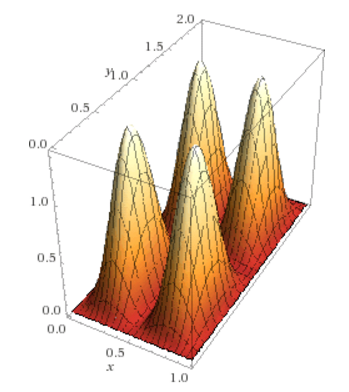
But things tend to get a whole lot more interesting when they’re circular (or cylindrical or spherical – see hydrogenic atoms!).
So let’s try and determine the wave functions for a circular 2D box of radius R, with zero potential (V) inside
the box and infinite potential outside the box. As with the case of the 1D box, this means the wave function is zero outside the
box:
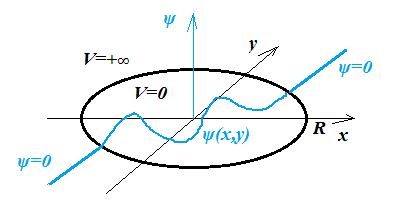
|
|
|
blogfast25
International Hazard
    
Posts: 10562
Registered: 3-2-2008
Location: Neverland
Member Is Offline
Mood: No Mood
|
|
Particle in a 2D circular box with zero potential energy (Ct'ued)
2. The problem described in polar coordinates:
In Cartesian coordinates (x,y), a 2D, one particle quantum system is described by the Schrödinger equation (here time-independent):
- \frac{\hbar}{2m} \bigg( \frac{\partial^2}{\partial x^2} + \frac{ \partial^2}{\partial y^2} \bigg) \psi(x,y) = [E-V(x,y)] \psi(x,y)
In our case we have:
V(x,y)=0
\implies - \frac{\hbar}{2m} \bigg( \frac{\partial^2}{\partial x^2} + \frac{ \partial^2}{\partial y^2} \bigg) \psi(x,y) = E\psi(x,y)
But this problem, because of the circular geometry, is easier to solve in polar coordinates:
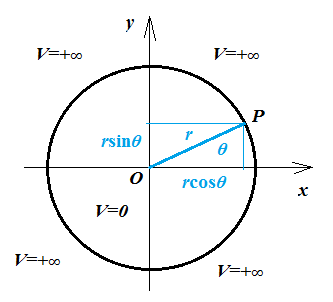
x=r\cos \theta\:\text{and }y=r\sin \theta\:\text{and }r^2=x^2+y^2
So we need to convert the Cartesian coordinates based equation to a polar coordinates based equation. I’ll also switch to u instead of ψ, because
of easier notation:
\psi(x,y) \to u(r,\theta)
This transformation of coordinates is tedious and finicky but is also well known (it can be found on plenty web pages), so I can just present the
polar coordinates Schrödinger equation, here:
-\frac{\hbar^2}{2m}\Big(\frac{\partial^2u}{\partial r^2}+\frac{1}{r}\frac{\partial u}{\partial r}+\frac{1}{r^2}\frac{\partial^2u}{\partial
\theta^2}\Big)=Eu
Slight reworking:
\frac{\partial^2u}{\partial r^2}+\frac{1}{r}\frac{\partial u}{\partial r}+\frac{1}{r^2}\frac{\partial^2u}{\partial
\theta^2}+\frac{2mE}{\hbar^2}u=0
For shortness of notation we set:
k^2=\frac{2mE}{\hbar^2}
\frac{\partial^2u}{\partial r^2}+\frac{1}{r}\frac{\partial u}{\partial r}+\frac{1}{r^2}\frac{\partial^2u}{\partial \theta^2}+k^2u=0
Due to:
u=0\:\text{for: }V=+\infty\:\text{,that is for: }r \geq R
... we have a boundary condition:
u(R,\theta)=0
<hr>
Next: separating the variables r and theta.
[Edited on 24-6-2016 by blogfast25]
|
|
|
aga
Forum Drunkard
    
Posts: 7030
Registered: 25-3-2014
Member Is Offline
|
|
Polar co-ordinates.
Now we're talking business ...
|
|
|
blogfast25
International Hazard
    
Posts: 10562
Registered: 3-2-2008
Location: Neverland
Member Is Offline
Mood: No Mood
|
|
You haven't lived if you haven't used polar coordinates! 
|
|
|
aga
Forum Drunkard
    
Posts: 7030
Registered: 25-3-2014
Member Is Offline
|
|
Astonishingly, i have !
I was introduced to them as a convenient way to plot shapes on a computer screen, then rotate those shapes.
|
|
|
blogfast25
International Hazard
    
Posts: 10562
Registered: 3-2-2008
Location: Neverland
Member Is Offline
Mood: No Mood
|
|
Grab a piece of chalk, the blackboard is yours! 
|
|
|
aga
Forum Drunkard
    
Posts: 7030
Registered: 25-3-2014
Member Is Offline
|
|
In 'normal' Cartesian co-ordinates, every point is defined as having an X,Y value relative to the Zero point where the X and Y axes cross.
Polar co-ordinates can define exactly the same spatial position using Distance (d) from a zero-point on the x-axis, and an Angle relative to that
x-axis.
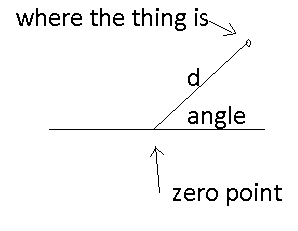
If you think about it, 'where the thing is' in Cartesian (normal X,Y) co-ordinates generates an Angle from the zero-point anyway, so you could use
trigonometry to work out what the Polar co-ordinates would be and vice versa.
For some problems, Polar co-ordinates simplify the maths enormously.
For example, in the one and only case where i used them, i defined a shape on a computer screen in Polar co-ordinates, each point desribed by a
Distance from zero and an Angle.
Simply by adding 1 to the Angle of every point, the entire shape rotated.
Changing the Zero point alters the position of the entire shape.
Adding/subtracting 1 from the Distance of each point alters the size of the entire share, retaining the overall structure.
In a Cartesian system this would be Much more difficult (take more time to solve) for each point in the plotted image.
Yes, i'm Pedagogically disabled.
You can take the chalk back now, Please.
[Edited on 25-6-2016 by aga]
|
|
|
blogfast25
International Hazard
    
Posts: 10562
Registered: 3-2-2008
Location: Neverland
Member Is Offline
Mood: No Mood
|
|
That wasn't a bad lecture, actually.
I like these plots: cycloids:
http://curvebank.calstatela.edu/cycloidmaple/cycloid.htm
|
|
|
blogfast25
International Hazard
    
Posts: 10562
Registered: 3-2-2008
Location: Neverland
Member Is Offline
Mood: No Mood
|
|
Particle in a 2D circular box with zero potential energy (Ct'ued)
3. Ansatz and separation of variables:
We assume u can be written as the product of two functions, one only dependent on r, the other only dependent on θ:
u(r,\theta)=R(r)Y(\theta)
Then we insert the assumed form of u into the PDE. This looks frightening (?) but because of the nature of u, it’s very easy. The first term e.g.
becomes:
\frac{\partial^2}{\partial r^2}u(r,\theta)=\frac{\partial^2}{\partial r^2}(R(r)Y(\theta))=Y(\theta)\frac{d^2R}{dr^2}=Y(\theta)R''
Ploughing on with the other terms we get:
YR''+\frac{1}{r}YR'+\frac{1}{r^2}RY''+k^2RY=0
Divide both sides by RY:
\frac{R''}{R}+\frac{1}{r}\frac{R'}{R}+\frac{1}{r^2}\frac{Y''}{Y}+k^2=0
Multiply both sides with r<sup>2</sup>:
r^2\frac{R''}{R}+r\frac{R'}{R}+\frac{Y''}{Y}+r^2k^2=0
Bringing the Y based term to the right and introducing a separation constant m<sup>2</sup>:
r^2\frac{R''}{R}+r\frac{R'}{R}+r^2k^2=-\frac{Y''}{Y}=m^2
So we obtain two ODEs, one in R(r):
r^2R''+rR'+\Big(r^2k^2-m^2\Big)R= m^2
... and one in Y(θ):
\frac{Y''}{Y}=-m^2
The value of the separation constant m<sup>2</sup> is yet to be determined.
[Edited on 25-6-2016 by blogfast25]
|
|
|
aga
Forum Drunkard
    
Posts: 7030
Registered: 25-3-2014
Member Is Offline
|
|
Ever the Master of the Cliff-Hanger 
As an aside, when polar co-ordinates are used in n-dimensions, is there any hard-and-fast rule dictating which axis the zero point lies on ?
I.e. in 3-D space it could be x,y,z or time ... or anything.
[Edited on 25-6-2016 by aga]
|
|
|
blogfast25
International Hazard
    
Posts: 10562
Registered: 3-2-2008
Location: Neverland
Member Is Offline
Mood: No Mood
|
|
Quote: Originally posted by aga  |
Ever the Master of the Cliff-Hanger 
As an aside, when polar co-ordinates are used in n-dimensions, is there any hard-and-fast rule dictating which axis the zero point lies on ?
I.e. in 3-D space it could be x,y,z or time ... or anything.
[Edited on 25-6-2016 by aga] |
The choice or origin and axis is usually yours and made out of mathematical convenience (there's no absolute origin for example).
In Cartesian coordinates we can describe a system of n dimensions, e.g. x<sub>1</sub>,x<sub>2</sub>,
x<sub>3</sub>, x<sub>4</sub>, etc. Of course you can't represent that graphically.
For spherical coordinates there's an unwritten convention:
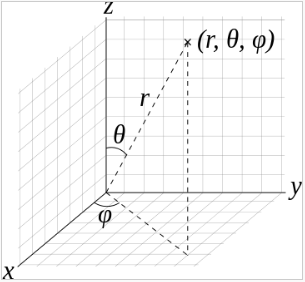
But really it's up to the user.
|
|
|
wg48
National Hazard
   
Posts: 821
Registered: 21-11-2015
Member Is Offline
Mood: No Mood
|
|
Then you haven't lived WELL if you haven't used Euler angles plus range their first and second derivatives their estimates and time.
But if you want to live really well you need to get in to metrics of relativity and black holes.
|
|
|
morganbw
National Hazard
   
Posts: 561
Registered: 23-11-2014
Member Is Offline
Mood: No Mood
|
|
Sorry gentlemen, I do like math and even calculus, I am not extremely well versed and I usually have to do some research to use it meaningfully. I
have not read all post in this thread and I am drinking just a little bit but it seems to me that this is a mastrubation post.
Self love screams from these post. Am I wrong? Think about it just a little. Calculus was developed between three and four hundred years ago, this is
not new shit. Difficult shit for sure, for most of us mortals, but entirely doable.
And no, I am not able to give the theorem of calculus in its entirety without hitting the literature, but I am able to hit the literature and do
pretty damn well. I am no doubt slower that a true mathematician, but tortoise or rabbit the end is the same place.
Please gentlemen, you are just who you are, please inform all of us when you are able to expand on ( an example, Newton ) his math and thoughts are
hundreds of years old. ( Can you do it without referencing perhaps Einstein )
No gentlemen, you cannot, because you are not the genius you wished to be. We play with the thoughts of those who came before us, (effing A, I do as
well )wishing to show something different/better, but it is not there yet, I do believe that it will be someday, but I am certain that it does not
exist in this thread.
|
|
|
blogfast25
International Hazard
    
Posts: 10562
Registered: 3-2-2008
Location: Neverland
Member Is Offline
Mood: No Mood
|
|
@morganbw:
Despite your unnecessary reference to 'mastrubation' [sic], your multiple spelling, grammar and punctuation mistakes, not to mention your conflation
between 'thread' and 'post', I'll keep this short and polite.
This is an educational thread for those who wish to learn something 'in house' about calculus and its applications in science. As such nothing new
occurs here, which of course is also true for 99 % of what goes on in other SM threads. That's the nature of something educational.
Maybe morgan wants to point to whatever it is that he has done here that hasn't already been done elsewhere and possibly a million times already?
Perhaps the many excellent but far, far from new (or unique) syntheses that are performed here by a few members are, by that reasoning, also
'm*st*rbation' and expressions of 'self-love'? (They are not, to be clear)
Finally, if you don't like the subject of this thread or how it's being presented, then don't read it. Inane comments like yours don't help one iota.
As regards:
| Quote: | | No gentlemen, you cannot, because you are not the genius you wished to be. |
Again that's offensive (but it's your right to be so) and wholly incorrect. I'm pretty sure know my limitations better than you know yours.
[Edited on 27-6-2016 by blogfast25]
|
|
|
aga
Forum Drunkard
    
Posts: 7030
Registered: 25-3-2014
Member Is Offline
|
|
Erm, in this thread I learnt at least a bit of Calculus from bloggers, and for Free !
For that reason alone, i am Very Glad this thread exists.
However the knowledge cums, i'm glad it does, no matter if it is from the enlightening words of morganbw or from Dr Flexi Jerkoff himself.
As it is a Maths thread, erm, perhaps you'd care to share some of your own pearls of wisdom ?
Edit:
I'll swap for my secret formula for actually making Aluminium Sulphate xHydrate crystals.
[Edited on 27-6-2016 by aga]
|
|
|
blogfast25
International Hazard
    
Posts: 10562
Registered: 3-2-2008
Location: Neverland
Member Is Offline
Mood: No Mood
|
|
Quote: Originally posted by aga  |
I'll swap for my secret formula for actually making Aluminium Sulphate xHydrate crystals.
|
Very slow, controlled evaporation of an Al sulphate solution, with careful nucleation should yield a defined hydrate as first crystals.
|
|
|
| Pages:
1
..
16
17
18
19 |